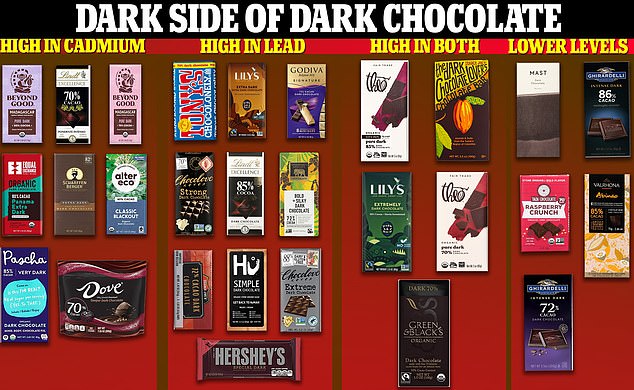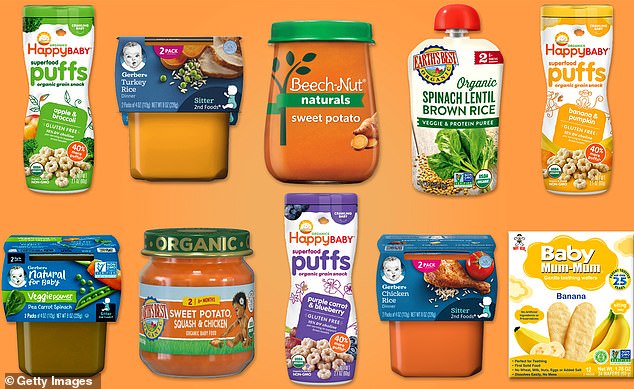Sweet lovers beware: Nearly half of popular chocolate bars on the U.S. market have been found to contain toxic metals that have been linked to devastating diseases, including cancer.
Researchers in Washington DC purchased and analysed 72 commercial cocoa products over eight years, testing them for heavy metals such as lead, cadmium and arsenic.
The levels were then compared to maximum thresholds set by California Proposition 65 (Prop 65), which regulates the amount of the toxic metal that can be found in food or drink.
They found that all the products contained traces of toxic metals and almost half had up to 20 percent more than the maximum permitted dose of lead. More than a third exceeded permitted levels of cadmium, which has been linked to cancer and kidney damage.
The George Washington University researchers did not reveal which chocolates were tested, although it is safe to speculate that at least popular brands such as Hershey’s, Reese’s and Kit Kats were considered for evaluation.
An analysis published in the journal Frontiers in Nutrition found that 72 chocolate samples contained toxic metals such as lead and cadmium, with more than half having levels above the maximum daily intake.
The team also noted that a single serving of these sweets would likely not cause health problems, but consuming multiple servings could pose dangers such as kidney dysfunction, heart disease and cancer.
The findings come amid other recent research that has estimated that thousands of cancer cases per year could be linked to foods laced with lead, cadmium and arsenic.
Dr Leigh Frame, study author and director of integrative medicine at the George Washington University School of Medicine and Health Sciences, said: ‘We all love chocolate, but it’s important to consume it in moderation, as with other foods containing heavy metals, including large fish such as tuna and unwashed brown rice.
‘While it’s not practical to completely avoid heavy metals in foods, you should be careful about what you eat and how much.’
According to the American Academy of Pediatrics (AAP), heavy metals such as lead, cadmium and arsenic can enter food products through soil, air, water or during the manufacturing process.
The team, from George Washington University, purchased 72 chocolate products between 2014 and 2022 from online retailers, stores like Whole Foods and distributor websites.
It is unclear where the tents were located.
The maximum daily thresholds, set by California Proposition 65, were 0.5 micrograms per day, 4.1 micrograms per day, and 10 micrograms per day for lead, cadmium, and arsenic, respectively.
This was one of the main caveats of the study, as California is known for having stricter limits on heavy metals than many other states and for leading the way in implementing restrictions.
All of the products tested positive for trace amounts of toxic metals. However, 43 percent of the chocolates exceeded the Prop. 65 maximum daily exposure level, and more than one in three chocolates had levels above that limit.
And, surprisingly, chocolates labeled “organic” had higher levels of lead and cadmium than their “non-organic” counterparts, totaling 3.2 micrograms per serving on average.

The chart above shows the 28 chocolate bars tested by the New York-based nonprofit Consumer Reports in a study independent of the one conducted by GWU researchers. All were found to contain lead and cadmium.

Toxic metals such as lead and cadmium have been linked to several brands of baby foods in studies separate from the one conducted by GWU researchers.
Lead has long been linked to a range of health problems, including developmental delays and behavioural problems in children. Some evidence also suggests that autistic children have more lead in their blood, but research is conflicting.
In addition, the EPA has classified lead and cadmium as probable human carcinogens, meaning they could cause cancer. Chronic exposure to cadmium has also been linked to kidney damage.
According to the FDA and CDC, there is no safe level of lead consumption.
Meanwhile, none of the products sampled exceeded safe levels of arsenic, a known carcinogen linked to lung, bladder and skin cancer, according to the American Cancer Society.
The team also observed that levels of all three metals decreased in the samples over the study period, which could be due to restrictive measures adopted in states such as California to limit exposure to heavy metals.
The study adds to a growing body of research suggesting high levels of toxic metals exist in chocolate, vegetables and even baby food.
A 2022 analysis by watchdog Consumer Reports, for example, found lead and cadmium in 28 chocolate products last year, including Hershey’s and Lindt.
The study was published Wednesday in the journal Frontiers in nutrition.

